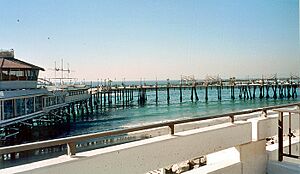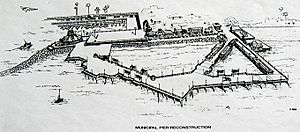Redondo Beach pier facts for kids
The Redondo Beach Pier is a famous pier located in Redondo Beach, California. It reaches out into the big Pacific Ocean. Over the years, the pier has been rebuilt many times. This happened because of strong storms and new building projects.
Its official name is "Municipal Pier." People have also called it the "Endless Pier." Older versions of the pier were known as "Pleasure Pier" and "Horseshoe Pier."
The pier area started as separate docks in the late 1800s. After many storms and demolitions, it became one connected structure in the 1900s. In the 1970s, the pier was very busy with tourists and local people. But its popularity started to drop after a nearby project failed in 1982.
In 1988, two winter storms badly damaged the pier. Then, on May 27, a problem with the electricity caused a huge fire. The fire was so big that traffic warnings were sent out for the freeway miles away. The pier we see today is made of strong reinforced concrete. It was finished in 1995. Since then, it has helped bring people back to Redondo Beach's business area.
Making the pier area popular again has been tricky. New plans must follow rules from the California Coastal Act. Also, the city needs a plan that local people will support. The "Redondo Landing" part of the pier has been improved. But the rest of the pier and the south end of the harbor are still waiting for new plans.
The city approved a big project with a mall developer. But this project was stopped by a lawsuit about environmental rules. Local citizens also started their own plan, and there was an appeal to the Coastal Commission. Because of these issues, the city and the developer stopped their project plans.
Local residents also voted on "Measure C." This measure was designed to prevent very large building projects. Measure C passed, even though the developer spent a lot of money trying to stop it. It became law and helps control building sizes near the pier.
Today, the pier and the south harbor area are still waiting for decisions from the city council. There is also a lawsuit from the developer about a lease agreement.
Contents
History of the Pier
Many Versions Over a Century
Early Piers (1800s)
- 1889–1915: The "Wharf No. 1" was built from iron and wood. It was near where the current pier is now. It helped bring timber from ships to trains. A storm later destroyed it.
- 1895–1920: The "Wharf No. 2" was a Y-shaped wooden pier. It had railroad tracks on one side and was for fishermen and tourists on the other. It was built south of Wharf #1. A storm in 1919 badly damaged it. It was later taken apart for safety.
Piers in the Early 1900s
- 1903–1926: The "Wharf No. 3" was a wooden pier built south of Wharf #2. It was used a lot by the lumber industry. After the lumber business slowed down, the pier was taken apart.
- 1916–1928: The "Endless/Pleasure Pier" was made of strong concrete. It was built by George W. Harding. It had a V-shape, with two long legs reaching out from the shore. A 1919 storm damaged it. It was later declared unsafe in 1928.
- 1925–Today: The wooden "Monstad Pier" was built by Captain Hans C. Monstad. It was used for fishing and pleasure boats. It started at 300 feet long and was made longer and wider in later years.
- 1929–1988: The wooden "Horseshoe Pier" was built after the Endless/Pleasure Pier was taken down. This pier was destroyed by a fire.
Piers in the Late 1900s
In 1983, the Monstad Pier was connected to the middle part of the Horseshoe Pier.
From 1988 to 1995, a Y-shaped part of the Horseshoe Pier that survived the fire stayed open. A smaller northern part was closed for safety. It was later removed when the new concrete pier was built.
The City of Redondo Beach held a special ceremony on July 29, 1993. This event announced that the pier would be rebuilt. The plans in 1993 included ideas for a carousel, a wax museum, an aquarium, and new restaurants. However, only one new restaurant was added, and the rest of the pier stayed open for people to walk on.
A formal ceremony by the City of Redondo Beach opened the newly rebuilt Redondo Beach Pier on February 11, 1995.
Pier Facts (Around 1990s)
Here are some facts about the Redondo Beach Pier from 1995:
- The Redondo Beach Pier is about 70,000 square feet in size.
- It sits about 25 feet above the water.
- It used over 3,000 cubic yards of strong concrete for its deck.
- It has 202 concrete support poles. The longest ones are 120 feet long.
- It took 5 years to start building and 18 months to finish.
- Over 150,000 hours of work were needed to build it.
- It is the largest "endless" pier on the California Coast.
- It is the seventh Municipal Pier built on the shores of Redondo Beach.
Filming Location
The Redondo Beach Pier has been used as a place to film many TV shows and movies:
- The popular TV series, The O.C., filmed scenes here.
- The TV series, Riptide, filmed here from 1984 to 1986.
- The movie Big Momma's House 2 also used the pier for filming.
- The remake of the show 90210 filmed scenes here with actor Trevor Donovan.




